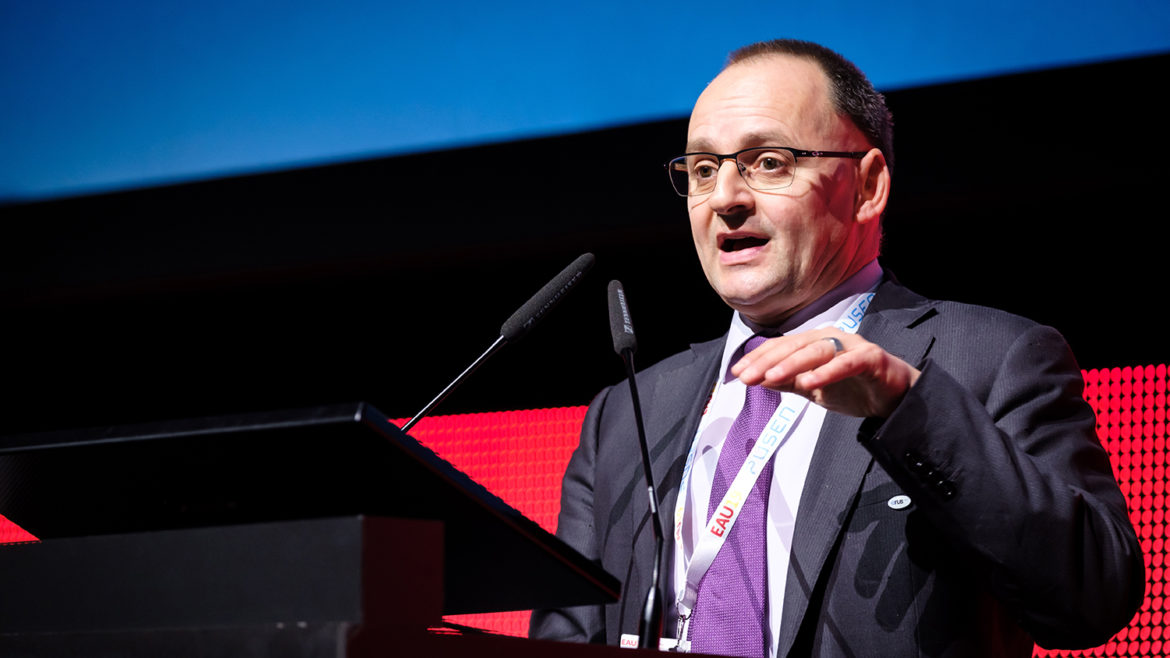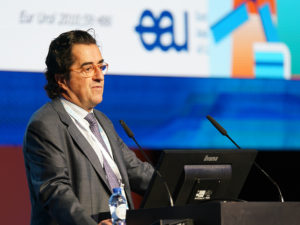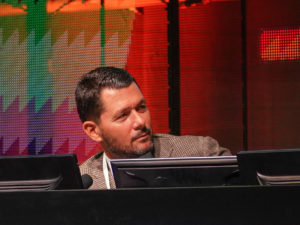As recently pointed out by ERUS Chairman Dr. Breda, robotic urologists are constantly widening their field, and the upcoming ERUS22 meeting should show a wide range of procedures beyond oncology. Prof. Hubert John (Winterthur, CH) is one of those robotic urologists taking robotic urology into new directions.
“Since we began using robots in urological surgery twenty years ago, urology has gone through a revolution. When we started we were happy to perform a radical prostatectomy and prove that potency and continence rate were comparable to non-robotic approaches.”
“From radical prostatectomy, we saw robotic applications moving to partial nephrectomies, cystectomies, and nowadays we have even standardised complex procedures like intracorporeal reconstruction after cystectomy. I’m sure that intracorporeal urinary diversion, for example, will be routinely performed in around five years. Every new step in the robotic evolution in urology has developed like that. Looking back across twenty years of robotic urology, we never stepped back in the longer term from new indications that had shown feasibility.”
Now, reconstructive surgery is the next domain for robotic urologists, according to Prof. John. “Following standardised organ-defined operations, reconstructive interventions will be more and more performed with robotic assistance. Pyelosplasties, ureteral reimplantations, urinary fistulas, Y-V- plasties, but also ileal ureteral replacement.”
“This is the further evolution of robotics in my opinion, moving into reconstructive interventions and the re-do operations. These operations need a lot of prior experience and routine as reconstructive urology does not have a fixed plan. You must be able to move in a preoperative fields.”
Rather than simply mimicking non-robotic procedures, robotic surgery also allows for completely new approaches that were previously impossible: “Robotic assistance allows us to work inside the small pelvis in narrow spaces, even behind the symphysis.”
Ideal circumstances
Prof. John has the benefit of working in a country where robotic urology is undisputed. Over 90% of the prostatectomies are conducted robotically (one of the highest rates in Europe) and the professional climate is conducive to developing and adopting new robotic procedures.
“It’s my impression that in Switzerland, the hospitals are in fact trying to do as many interventions as possible using robotic systems (and we may actually have too wide a variety of robotic systems already!). More interventions on a robotic system reduces the fixed costs per intervention. We already know the other benefits, so there is no need to convince the hospital administrators there: less blood loss, pain, fewer complications all leading to short hospital stays and faster recovery, having a major impact on total health costs of a country.”
“In my experience, robotic surgery is extremely cost effective overall. In cost discussions, everybody only focuses on his or own task, like hospital expenses, insurance and so on, but you never see the complete picture of total costs. When you calculate the whole burden of costs, you’ll see robotic urology is in fact a cheap thing.”
“Just as an example, in my hospital we have a mean hospital stay of 11 days for a radical cystectomy with intracorporeal urinary diversion. The benchmark overall in Switzerland is still 19 days. If you can reduce the hospital stay following the most difficult urological intervention by eight days, there should be really no discussion any more about costs.”
Scientific Programme and Live Surgery
With more emphasis on the great diversity of robotic urology, the ERUS22 scientific programme crams a lot into two-and-a-half days. Prof. John: “I’d say it’s a great programme, there are many nice and worthwhile lectures in the main sessions, with excellent and experienced speakers and moderators. I’m sure we can expect some great discussions.”
“There are also four excellent ESU courses, including an advanced robotic reconstructive urology course on the Wednesday. These courses are designed to be extremely helpful for daily operative work.”
“Of course the real highlight of any ERUS meeting is the live surgery. In my opinion, live surgery has a very high educational value. We need to perform it very carefully and follow every ethical guideline and recommendation. The teams need to be well prepared, and we need to select appropriate, routine cases.”
Prof. John will be presenting about urological fistula repair and the role of robotic surgery during Plenary Session 4. Later that day, he and his team will be performing a robotic vesico-vaginal fistula repair in Barcelona.
“As soon as the patient is selected, we will receive the patient history and we can start preparing. We will visit the patient on the day before the procedure and I will do my best to also visit her after.”
“I will be bringing my table-side assistant as well as my robotic specialist for live surgeries. It’s not that I don’t trust the local team, but we want to create optimal conditions for the patient. It’s best when I have my people beside me and I can speak in Swiss German if we run into any difficulties.”
- Registration is open for ERUS22 in Barcelona. The discounted late fee is available until 22 September. After that, the on-site fee is applicable. Several price points are available for EAU members, residents and nurses.



